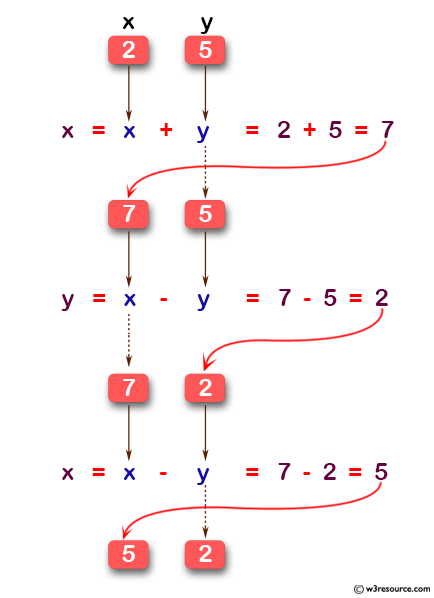Swapping algorithm
The problem
Sometimes we could encounter a situation where we have two variables, for example a and b
(each with its own value), and we want to mutually exchange their numbers so that a takes
the value of b and b gets the value of a. The problem is that we cannot simply invert
the numbers using just two variables because when a value is passed from one variable to the
other you replace the old number with a new one and you lose it forever. Read this example
line by line:
a = 5;
b = 2;
// doesn't work
a = b; // now a = 2
b = a; // ❌ no!
The assignment happens always from right to left!
In line 6 you've lost the value of a (5) by replacing it with b (2), so you can't assign 5 anymore.
If we printed a and b with this code we would get that a = 2 and also b = 2.
The solution
We have many ways to solve this issue, but one of the easiest and more intuitive is to use the swapping algorithm, which permits swapping the two variables without losing their content.
The idea is to make a new temporary variable, usually called temp, where you store one of
the two values of the variables you want to swap in order to prevent a value from being lost.
You then take back the value stored in it and put in the correct variable where you
swapped its value, obtaining the desired result.
To explain this better, let me make an analogy with a real example. You have three glasses:
- One filled with wine,
a - One filled with beer,
b - One empty,
temp
To swap wine and the beer inside a and b you have to follow the procedure below.
In code, this concept translates into the following program:
#include <iostream>
using namespace std;
int main() {
int a = 5,
b = 2,
temp;
cout << "before swapping:" << endl;
cout << "a = " << a << ", b = " << b << endl;
temp = a;
a = b;
b = temp;
cout << "\nafter swapping:" << endl;
cout << "a = " << a << ", b = " << b << endl;
return 0;
}
Output
before swapping:
a = 5, b = 2
after swapping:
a = 2, b = 5
The process can also be illustrated more abstractly like in this diagram:
In step 1 the value of a goes into temp, then in step 2 the value of b goes into
a and finally in step 3 the value of temp goes into b. Obviously, the order of these
actions must be respected.
Alternatives
An alternative approach is to use addition and subtraction between the two values of the variables involved. The advantage is that we don't have to rely on a third variable for support.
a = a + b;
b = a - b;
a = a - b;

Some languages, like Ruby, Python and JavaScript (which since version ES6 supports destructuring operators) can perform parallel assignments, which simplifies the notation for swapping two variables1:
[a, b] = [b, a];
